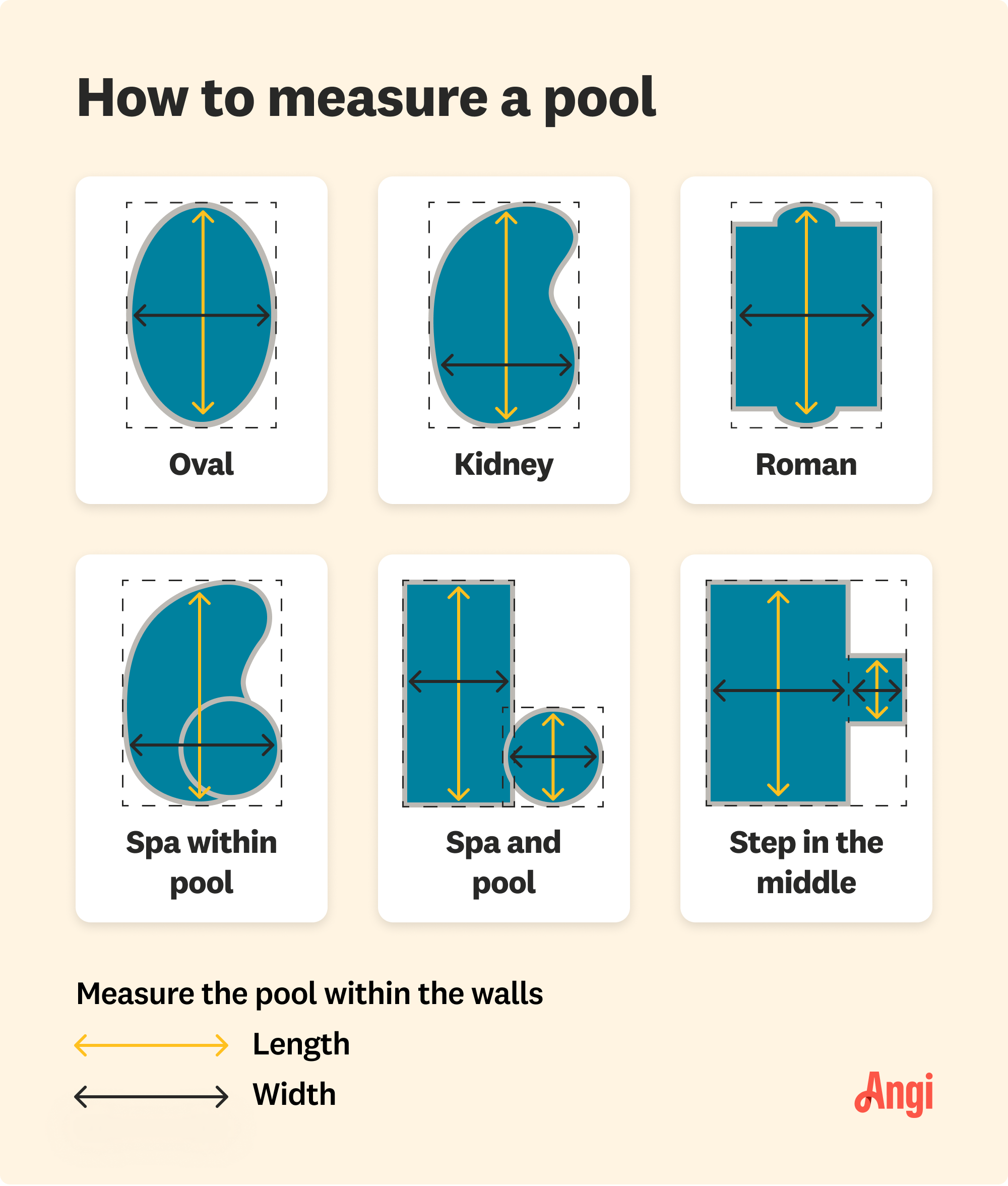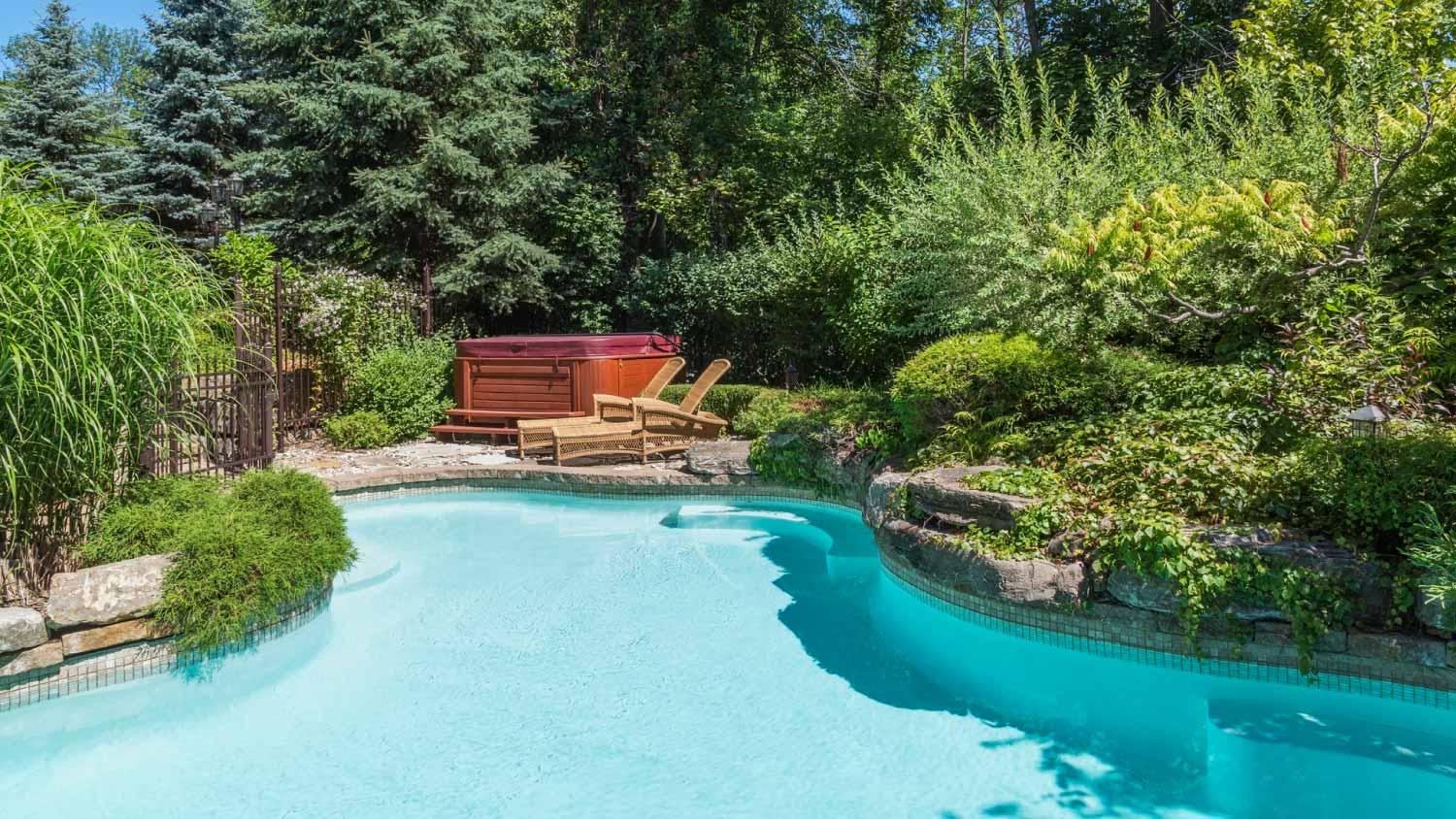
Thinking about switching from chlorine to salt water in your pool? Learn how much a saltwater pool conversion costs in this informational guide.
The right size pool can really help you make a splash


Inground pools typically range from 10 by 20 feet to 20 by 40 feet.
Above-ground pools are usually between 10 and 24 feet in diameter.
Lap pools can be as small as 6 by 30 feet or as large as 10 by 50 feet.
Plunge pools are small, ranging from 6 by 10 feet to 8 by 20 feet on average.
Endless pools generally range from 9 by 15 feet to 15 by 20 feet.
You can get a pool as small as 6 by 8 feet.
Pools come in all sorts of shapes and sizes, ranging from small plunge pools designed for a quick dip to vast Olympic pools meant for swimming competitions and everything in between. The right size pool for you depends on what you plan to use it for, your personal aesthetic, your budget, and, of course, how much space you have for it.
Learn everything you need to know about swimming pool sizes so you can find the perfect type for your unique yard and swimming habits.

When taking on this project, expect questions only a pro can answer. With our network of local pros, you'll get the job done and your questions answered—without the hassle and stress of doing it yourself.
Popular pool sizes can vary quite a bit based on the shape and type of pool you choose, but our comprehensive pool size chart shows all of the most common sizes. The table below is your best resource for picking the ideal pool size for your space and lifestyle.
| Pool Type | Common Depths | Popular Sizes (in feet) | Average Number of Gallons | Common Uses |
|---|---|---|---|---|
| Inground | 3 – 10 feet | 16 x 32, 18 x 36, 20 x 40 | 19,200–30,000 | Recreation |
| Above ground | 3 – 5 feet | 10, 16, and 24 feet in diameter | 5,800–15,300 | Recreation |
| Olympic | 7 – 10 feet | 154 x 82 | 660,000 | Laps and diving |
| Lap | 5 – 10 feet | 10 x 40, 8 x 50, 6 x 40 | 10,800 | Laps |
| Plunge | 5 – 7 feet | 6 x 10, 8 x 12, 8 x 20 | 1,000–3,200 | Recreation |
| Endless | 4 – 8 feet | 9 x 15, 12 x 18, 15 x 20 | 1,000–7,200 | Recreation |
| Freeform | 4 – 10 feet | 12 x 30, 15 x 35, 18 x 40 | 18,000–20,000 | Recreation |
| Small | 4 – 6 feet | 6 x 10, 8 x 12, 12 x 20 | 3,760–9,900 | Recreation |
Inground pool dimensions vary widely, and sizes often depend on the pool's materials. For instance, vinyl pools don't often come in custom shapes and sizes, so there are usually three standard sizes to choose from: 16 by 32 feet, 18 by 36 feet, or 20 by 40 feet. However, concrete pools can come in just about any size and shape imaginable, making them a better option for people who have a very specific swimming pool design in mind.
Common inground pool dimensions (in feet) include:
10x20
12x24
14x28
16x32
18x36
20x40
Above-ground pools, as you’ve probably noticed, are usually circular. You can find some oval-shaped above-ground pools, but they're not as common. Most above-ground pools are 24 feet in diameter, but there are many sizes available.
Common above-ground pool sizes (by diameter) include:
10 feet
14 feet
16 feet
18 feet
20 feet
24 feet
Pool installers standardize Olympic pool dimensions to ensure fairness during swimming competitions. The standard size for an Olympic pool is 154 by 82 feet. Since they're so large, it’s rare that someone would opt to install one in their backyard.
You’ll be busy swimming laps in a lap pool, just as the name implies. Because of the nature of this particular activity, this pool type is relatively long and narrow. It’s a great option if you love to get your exercise in the water, but the cost of lap pools is often higher than many other pool types due to their length.
Common lap pool sizes (in feet) include:
6x30
6x40
8x40
8x50
10x40
10x50

Plunge pools are smaller pools designed for sitting and relaxing rather than exercising. They're ideal for homeowners with small yards or for anyone who doesn't want their pool to take up too much precious yard space. A plunge pool costs anywhere from $10,000 on the low end to $50,000 on the high end, so it’s not quite as wallet-friendly as, say, an above-ground pool, but it’s still a great option for those looking for a simple, relaxing soak and less overall maintenance time.
Common plunge pool dimensions (in feet) include:
6x10
6x12
6x15
8x12
8x15
8x20
Endless pools feature a built-in current that you can swim against, creating an effect that's similar to running on a treadmill. These types of pools are great for getting in some swimming exercise, and thanks to their current, the pools don't need to be very big to be effective. Despite the name “endless pool,” they’re not truly endless and do, indeed, have a start and end point. They typically start at 9 by 15 feet, but you can find larger sizes, as well.
Common endless pool sizes (in feet) include:
9x15
10x12
12x14
12x16
12x18
15x20
Freeform pools usually feature custom, organic shapes with rounded edges and irregular curves that can mimic the appearance of a natural body of water. Add-ons like backyard waterfalls and rock formations often accompany these pools, which can make them look even more spectacular in your space. Due to their custom design, freeform pools come in a wide range of dimensions that are typically customizable based on the look you want.
Common freeform pool sizes (in feet) include:
12x27
12x30
15x32
15x35
16x30
17x32
If you don't have a very large backyard, a small pool can come in handy, offering a refreshing retreat on hot summer days without encroaching on too much square footage. Small pools are typically 12 by 20 feet or less.
Common small pool sizes (in feet) include:
6x8
6x10
8x10
8x12
10x16
12x20
Before you decide which pool you’ll spend the summer in, be sure to keep a few important factors in mind. For instance, the size of your backyard, as well as how many people you plan on inviting over for a swim party, can affect your perfect pool size, as can the type of pool you want.

When considering pool size, it's important to factor in how many people will be using the pool on a regular basis. If you have a large household or frequently host the best pool parties in the neighborhood, you may want to invest in a larger pool to accommodate everyone. Not only will people have more space to swim and play, but this extra space will prevent the pool from getting too crowded. If you have a smaller household, however, you can definitely get away with a smaller pool.
In addition to the size of your household, you should consider the size of your yard. Clearly, larger yards can accommodate larger pools. However, you should also think about how much of your yard you want to dedicate to a pool. Maybe you have a relatively large yard but also want to leave room for landscaping and other outdoor activities, in which case you probably don't want to install the largest pool that can fit in your yard.
There are many types of pools, and they all vary by shape, materials, and installation. The type you choose can affect your size options. For instance, it's pretty tough to find very large above-ground pools, so if a large size is your priority, you probably want to invest in an inground pool. Additionally, vinyl and fiberglass pools don't come in nearly as many shapes and sizes as concrete pools, so keep that in mind when deciding on pool materials.
Pools can serve many purposes, so think about your primary reason for getting a pool before deciding on a size. For instance, if you plan to use the pool for exercise and swimming laps, you'll either need a pretty big pool or an endless pool. But if you just want the pool for casual dips while enjoying summer cocktails, a smaller pool, like a plunge pool, will perfectly complement your space.
For many of us, the cost to install a pool is a critical factor. Installing an inground pool typically costs between $39,000 and $70,000, while the cost to install an above-ground pool ranges from $1,000 to $6,000. In both cases, opting for a large pool will usually drive up your installation costs, so if you have your heart set on a big pool, budget for costs that fall on the higher end of those price ranges.
The size of your pool can also affect maintenance and equipment costs, including what size heater you need. Generally, larger heaters cost more than smaller heaters, and since a large pool has more surface area that can collect dirt, debris, and algae, cleaning it will generally cost more than cleaning a small pool. For instance, if you need to empty the pool to scrub the walls, you'll need to factor in the cost to fill a pool, which ranges from $4 to $10 per 1,000 gallons, meaning you’ll pay more to fill a larger pool.
The best pool size for you depends entirely on your needs, budget, and lifestyle. When weighing your options, consider things like your budget for installation and ongoing maintenance costs, as well as the size of your yard and the number of potential swim buddies.
It's also helpful to think about what you plan to use the pool for, be it exercise, leisure, or something else. When in doubt, you can always consult a pool designer near you to help you land on the perfect size pool that the whole family will love for years to come.
From average costs to expert advice, get all the answers you need to get your job done.

Thinking about switching from chlorine to salt water in your pool? Learn how much a saltwater pool conversion costs in this informational guide.

Pool inspections are crucial when buying a home with a pool, spa, or hot tub. Learn how much a pool inspection costs and how potential problems are diagnosed.

Installing a pool heater ensures that your pool gets used as much as possible, but is the pool heater cost worth it? Let’s find out.

How much shock does my pool need? Here's how to calculate how much pool shock to add to your pool based on its overall water condition.

If you’re looking to get your backyard summer-ready, use this guide to learn pool opening costs, budget appropriately, and how to save money.

It’s always best to hire a pool electrician to work on your pool's electrical systems. Our guide breaks down everything you need to know about hiring this pro for your pool.